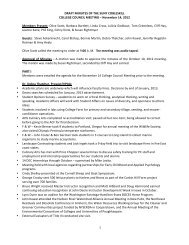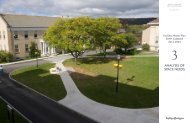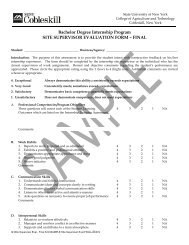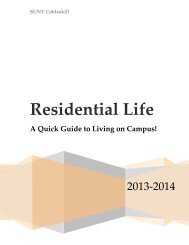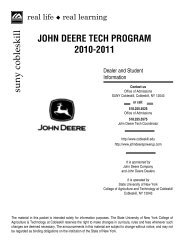Part 5: Final Recommendation - SUNY Cobleskill
Part 5: Final Recommendation - SUNY Cobleskill
Part 5: Final Recommendation - SUNY Cobleskill
Create successful ePaper yourself
Turn your PDF publications into a flip-book with our unique Google optimized e-Paper software.
NGREENING<br />
<strong>SUNY</strong> <strong>Cobleskill</strong> Facilities Master Plan – Phase 5 Report<br />
November 2011<br />
N – GREENING<br />
<strong>SUNY</strong> <strong>Cobleskill</strong> has made substantial gains in providing a more<br />
sustainable and environmentally friendly campus environment.<br />
While the FMP is not a sustainability plan per se, there are many inherent<br />
elements that have a significant impact on <strong>SUNY</strong> <strong>Cobleskill</strong>’s ecological<br />
footprint. Some highlights include:<br />
•<br />
•<br />
•<br />
•<br />
Reducing Car Travel and Creating a More Walkable Campus<br />
The FMP provides building connections in all the master planning<br />
concepts dramatically reducing the outdoor cross-campus travel<br />
and creating a more pedestrian-friendly walking environment<br />
indoors. Over the course of the FMP process it was noted that<br />
some students and faculty will drive from one point on campus<br />
to another in an effort to avoid walking outdoors (especially in<br />
inclement weather). This results in unnecessary vehicle miles<br />
traveled.<br />
A Focus on Building Reuse<br />
A core principle of the FMP is to maximize the use of existing<br />
buildings and only suggest new construction when necessary.<br />
The construction of a building generates as much waste (from<br />
material harvesting, fabrication and assembly) as the volume<br />
of the building being built. By focusing on adaptively reusing<br />
buildings, such waste is avoided.<br />
Harnessing Building Renovation to Improve Performance<br />
Because the FMP foresees the extensive renovation of most campus<br />
facilities within the next 10-15 years, the FMP represents an<br />
outstanding opportunity to improve building system performance<br />
for the next 30 to 40 years. While the Fund and the campus must<br />
conform to Executive Order 111 and meet LEED Silver status, a<br />
commitment to push for LEED Gold could pay significant longterm<br />
operating dividends.<br />
Better Synergy Between Indoor and Outdoor Environments<br />
By creating a better connection between indoor and outdoor<br />
spaces (as well as improving the quality of outdoor spaces), the<br />
FMP creates the opportunity to reduce heating and cooling loads<br />
in spring and fall by opening spaces up to the change of seasons<br />
and the comfortable temperatures of those months.<br />
•<br />
Planting and Maintaining Native and Site Appropriate<br />
Vegetation<br />
The FMP also calls for a landscape master plan to coordinate<br />
the design of the anticipated amount of site improvements. As<br />
part of this work, maintenance-intensive vegetation and turf<br />
are to be mitigated with native and site appropriate plantings,<br />
groundcovers, and areas of no-mow or low-mow grass and<br />
herbaceous vegetation.<br />
Other sustainable initiatives for the College to consider are in areas<br />
of energy, water management, recycling and waste management, and<br />
transportation.<br />
ENERGY<br />
Survey & Meter Existing Usage<br />
Provide meters for all facilities to accurately monitor existing electrical,<br />
natural gas and water consumption. For a minor premium, the campus<br />
can elect to purchase green power for a portion of its energy usage.<br />
Equipment Upgrades & Cogeneration<br />
Ensure that all future equipment purchased and installed on campus meets<br />
minimum energy performance guidelines. Construct all new buildings<br />
with energy-efficient mechanical and electrical systems.<br />
As the campus expands, the localized cogeneration (micro turbines)<br />
should be explored. Cogeneration involves the capture and reuse of heat<br />
generated in the on-site production of electricity (often through the use<br />
of natural gas). That heat is then used in heating and cooling systems.<br />
Cogeneration involves significant upfront capital cost, but can dramatically<br />
lower long term utility costs. Furthermore such efforts capitalize upon ongoing<br />
research being conducted at the College’s Center for Environmental<br />
Science & Research [CEST].<br />
Renewable Solar Energy<br />
Consider installing photo voltaic or radiant solar panels to supplement<br />
hot water supply for the campus.<br />
Renewable Wind Energy<br />
Given the College’s extensive land holdings, some of which are hilltops<br />
to the north side of the valley, there is potential for wind turbines – though<br />
there has been notable opposition to such structures in the nearby Catskill<br />
Park.<br />
Geothermal Energy<br />
Many portions of the campus are appropriate for installing geothermal<br />
systems as an efficient way to provide heating and cooling for campus<br />
buildings. Using the relatively stable and moderate temperature of the<br />
ground that exists starting several feet below the surface, the ground can<br />
be used as an efficient heat source or sink to provide heating and cooling<br />
to buildings on the campus. A ground-source heat pump system would<br />
need to be a vertical well system in the denser areas of the campus, but<br />
where sufficient open space exists, there is an opportunity for a lessexpensive<br />
horizontal loop system. We recommend conducting thermal<br />
conductivity tests before designing vertical well systems. While the<br />
upfront cost is higher for a geothermal system than for other heating<br />
and cooling systems, the investment can provide long-term returns in<br />
reduced operating costs, especially if economic incentives are offered to<br />
the campus or energy prices rise.<br />
WATER<br />
Wastewater and Stormwater Management<br />
<strong>SUNY</strong> <strong>Cobleskill</strong>’s agricultural programs potentially generate a significant<br />
amount of agricultural waste and nutrient pollution from stormwater<br />
runoff. The College should obtain the services of civil engineer to design<br />
and implement enhanced best management practices and stormwater<br />
runoff control and treatment before it enters the <strong>Cobleskill</strong> Creek. The<br />
Nutrient Management Plan for the campus should receive regular review<br />
and updates to ensure the best available technologies and systems are<br />
being used and demonstrated to students and the community.<br />
The potential to incorporate algal turf scrubbers (ATS) should be considered<br />
due to their potential to feed back into the agricultural or bio-energy<br />
production programs on campus.<br />
70



